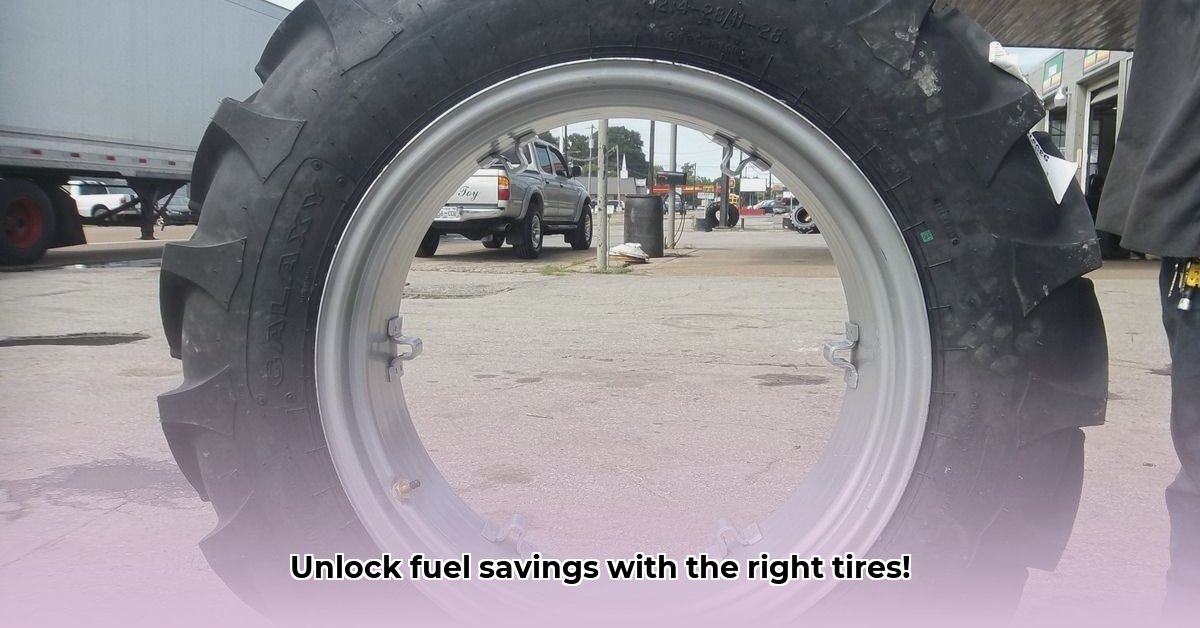
Choosing the right tires for your tractor is a critical decision impacting fuel efficiency, traction, and overall operational costs. This guide focuses on 12.4 x 28 tractor tires, providing actionable advice for selection, maintenance, and understanding future technological advancements. For more detailed information on tractor tire selection, check out this helpful resource: TSC Tractor Tires.
Understanding Your 12.4 x 28 Tractor Tires: More Than Just Rubber
The dimensions "12.4 x 28" define the tire's size, a crucial factor determining performance and fuel efficiency. Just as a marathon runner needs the right shoes, your tractor needs appropriately sized tires for optimal operation. The right tires contribute significantly to fuel savings and overall cost-effectiveness over the tire lifespan. Improper tire selection can lead to increased fuel consumption and premature tire wear.
Selecting the Perfect 12.4 x 28: Matching Tires to Your Terrain and Tasks
Tire selection goes beyond size. Several factors must be considered to ensure a perfect match for your specific needs and working conditions.
Field Conditions: Are your fields heavy clay, easily compacted soil, or lighter, sandier loam? Traction is paramount. Aggressive lug tires excel in mud but wear faster on paved surfaces. Radial tires offer better road performance and fuel economy but sacrifice some mud traction.
Tractor Specifications: Consult your tractor's owner's manual for recommended tire specifications, ensuring compatibility and preventing potential damage. Ignoring this risks tire failure and tractor damage. Overloading tires compromises their integrity, leading to early wear and potential failure.
Operational Demands: Intensive use or heavy loads demand higher load-bearing tires. Consider the tasks performed regularly. Consistent heavy hauling requires increased load capacity compared to occasional light fieldwork.
Maintaining Your 12.4 x 28 Tires: Simple Steps for Long Life and Fuel Savings
Regular maintenance is crucial for maximizing tire lifespan and fuel efficiency. These practical steps should be integrated into your farm's routine maintenance schedule.
Regular Pressure Checks: Consistent proper inflation is paramount. Underinflation significantly increases rolling resistance, wasting fuel and accelerating wear. Overinflation reduces traction and damages the tire structure. Use a calibrated gauge and adhere to the manufacturer's recommended pressure. (Tip: Check pressures before each use.)
Tire Inspections: Regularly inspect tires for cuts, embedded objects, or uneven wear. Early detection prevents minor issues from becoming expensive repairs or catastrophic failures. (Tip: A thorough inspection should be conducted at least monthly.)
Proper Storage: Avoid prolonged exposure to sunlight and extreme temperatures. Heat degrades rubber, causing brittleness and shortening the tire's lifespan. Storing tires in a cool, dry location extends their life. (Tip: Cover tires when not in use.)
The Future of 12.4 x 28 Technology: Innovations on the Horizon
The agricultural tire industry constantly evolves. Advancements promise even greater fuel efficiency and durability.
Advanced Rubber Compounds: New rubber compounds offer increased durability, wear resistance, and improved traction, extending tire lifespan and reducing fuel consumption.
Self-Sealing Technology: Self-sealing tires minimize downtime from punctures, reducing repair costs and maintenance time. (Tip: Look for tires with this feature when possible.)
Sustainable Materials: Manufacturers increasingly use recycled materials and eco-friendly processes, reducing the environmental impact of tire production and disposal.
Comparing 12.4 x 28 Tire Options: A Quick Overview
The following table provides a simplified comparison; always consult individual product specifications for accurate data. Remember, the initial cost is only one factor; compare the total cost of ownership over the tire's lifespan.
| Feature | Option A (Example) | Option B (Example) | Option C (Example) |
|---|---|---|---|
| Tread Pattern | Aggressive Lug | Moderate Lug | Radial, Low Profile |
| Load Capacity | 2500 lbs | 2800 lbs | 3000 lbs |
| Fuel Efficiency | Good | Excellent | Very Good |
| Price | Moderate | High | High |
| Expected Lifespan | 3-4 years | 4-5 years | 5+ years |
How to Maximize Fuel Efficiency with 12.4-28 Tractor Tires
Key Takeaways:
- Proper tire inflation is critical for fuel efficiency. Underinflation increases fuel consumption. Overinflation decreases traction and increases tire wear.
- Tire selection drastically affects fuel consumption. While larger tires might seem beneficial, their impact on engine load and fuel efficiency must be assessed.
- Regular maintenance is crucial for both fuel efficiency and tire longevity. This includes pressure checks and tread depth inspections.
- Understanding your tractor's specifications and operating conditions is essential for optimal tire selection and pressure. Load and terrain are defining factors.
- Innovative technologies like liquid tire ballast can boost traction and efficiency without changing air pressure.
Proper tire inflation is paramount for maximizing fuel efficiency in 12.4-28 tractor tires. Underinflation leads to increased rolling resistance, directly impacting fuel consumption. Overinflation, while seemingly efficient, reduces traction, accelerates wear, and nullifies potential savings. Maintaining optimal pressure is key.
Proper tire maintenance is crucial. Regular pressure checks, thorough inspections, and appropriate storage all impact both fuel efficiency and tire lifespan. Prioritizing tire care is an investment in the long-term health and productivity of your farming operation. A little attention and maintenance will return significant savings over time.